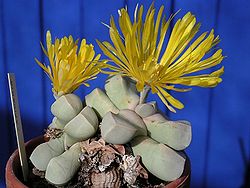| Lapidaria margaretae | |
|---|---|
 | |
| Flowering Lapidaria margaretae | |
| Scientific classification | |
| Kingdom: | Plantae |
| Clade: | Tracheophytes |
| Clade: | Angiosperms |
| Clade: | Eudicots |
| Order: | Caryophyllales |
| Family: | Aizoaceae |
| Subfamily: | Ruschioideae |
| Tribe: | Ruschieae |
| Genus: | Lapidaria (Dinter & Schwantes) N.E. Br. |
| Species: | L. margaretae |
| Binomial name | |
| Lapidaria margaretae | |
| Synonyms | |
| |
Lapidaria is a monotypic genus of dwarf succulent plants in the family Aizoaceae. The only species it contains is Lapidaria margaretae, also known as the Karoo rose. [1]